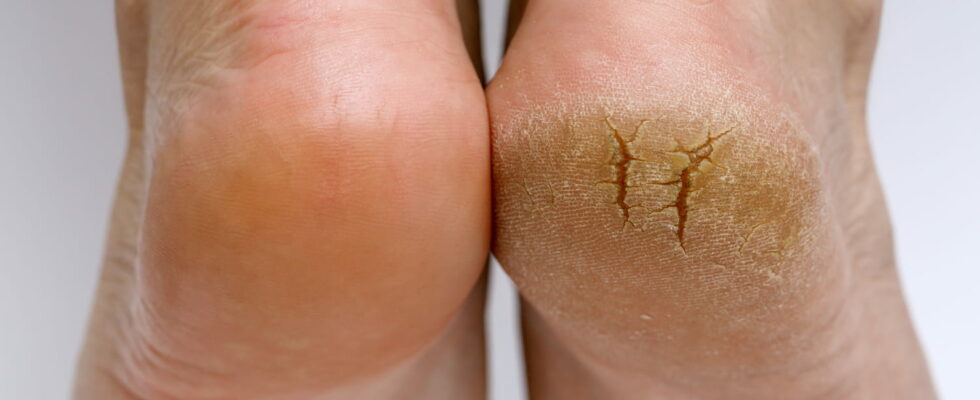Cracks usually develop on the heels of the feet or on the hands where the skin is very dry. How to treat them? Naturally? With honey? Bandages ? Cream ?
Cracks in the feet, heels, hands… are common, especially when it’s cold and the skin is extremely dry. How to recognize them? What is it due to? How to treat them? With some natural remedies or grandma?
Definition: what is a crack?
Subjected to external aggressions such as cold, humidity, friction and various types of work, the skin sometimes becomes fragile until it cracks more or less deeply: this is called crevices. These more or less deep and more or less visible lesions of the skin can have trouble healing and become infected. If the cracks are the more often localized on the feet and hands, they can also affect the lips and their periphery (chapped skin) and the breasts in breastfeeding women.
Photo of a crack on the heel of the foot
What causes cracks?
Cracks on the hands are usually due to skin dehydration caused by the joint action of cold and repeated contact with water. Localized cracks in the feet and heels are often the consequence of the daily aggressions suffered during walking, associated with a lack of hydration. Walk barefoot or with uncomfortable or unsuitable shoes may aggravate the phenomenon. But as Dr. Roux explains, the crack initially comes from a keratin thickening (therefore of the epidermis) on which goes appear a cut. “Then you have to differentiate between two scenarios : either the thickening and the lesions are localized, in which case it is indeed a simple crack, or they are diffuse and extend over a larger surface or even over several parts of the body, in which case it is necessary to ask if the crack is not associated with another skin condition such as eczema (atopic or allergic) or psoriasis. “
What are the symptoms of a fissure?
The crack appears on a thickened area of the epidermis, in the form of more or less visible cracks. The skin, then open to bacteria, is more vulnerable to infection and can become red, inflamed and painful. It can also peel or even bleed.
What treatment to treat a crack?
The treatment of the crack is essentially based on the intense rehydration of the skin and its repair using a healing ointment. “In the event of extensive, recurrent and resistant cracks, the treatment will then be different and will no longer be based solely on repairing the skin.”
► With a restorative cream : There are a large number of them, which allow both to cleanse and hydrate the affected area. Their composition is both moisturizing and bacteriostatic. “The most effective keratolytic creams are based on urea, lactic acid or salicylic acid” says Dr. Roux.
► With bandages and heels: adapted to the shape of the heel, they contain moisturizing and treating gel and provide effective pain relief while treating the crack.
► With lemon: Lemon is one of the best-known “grandmother’s remedies” for combating cracks. Her moderate efficiency is based on the action of its fruit acids. As a regular foot bath, it can help dissolve and remove dead skin, and help reduce calluses.
► With petroleum jelly: reference emollient, the petroleum jelly is very effective in treating cracks by promoting wound healing. Another string to his bow: Vaseline is bactericidal. It can easily be applied several times a day to the affected area.
► With honey: Renowned for its healing properties, honey can be used to relieve cracks, especially those located on the nipple of breastfeeding women. There are, moreover, irradiated honey creams on sale in pharmacies.
► With green clay: healing, soothing and antibacterial, theGreen clay proves to be an ally of choice against crevasses. Mixed with olive oil, it can be used as a poultice on the lesions, to leave on for about thirty minutes.
► With coconut oil: its great emollient power makes coconut oil an effective natural treatment for superficial cracks.
What preventive care or actions?
Even if all skin types are not equal in the face of the risk of cracks, adopting the right gestures and the right care to prevent them is always effective.
- Use gloves for washing dishes and housework
- Dry your hands and feet thoroughly after washing them
- When the skin on the heels is very thick, regularly use a keratolytic cream, which, by accelerating cell renewal, will help reduce the callus.
- Use a very oily and nourishing cream daily.
- Avoid wearing certain shoes without a buttress, such as flip flops, mules or clogs, which do not support the foot and increase trauma.
- “Beware of anti-callus rasps which, as Dr. Roux explains, can stimulate the production of keratin in reaction to its aggressive mechanical action.”
Thanks to Dr Marie-Estelle Roux, dermatologist in the Paris region.
